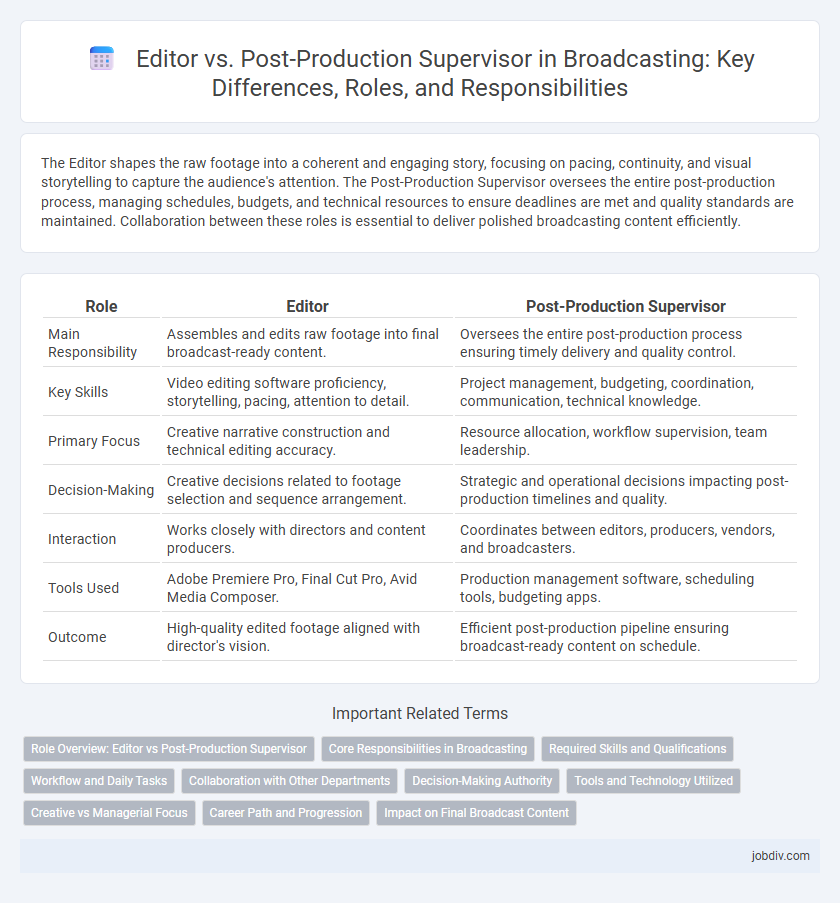The Editor shapes the raw footage into a coherent and engaging story, focusing on pacing, continuity, and visual storytelling to capture the audience's attention. The Post-Production Supervisor oversees the entire post-production process, managing schedules, budgets, and technical resources to ensure deadlines are met and quality standards are maintained. Collaboration between these roles is essential to deliver polished broadcasting content efficiently.
Table of Comparison
| Role | Editor | Post-Production Supervisor |
|---|---|---|
| Main Responsibility | Assembles and edits raw footage into final broadcast-ready content. | Oversees the entire post-production process ensuring timely delivery and quality control. |
| Key Skills | Video editing software proficiency, storytelling, pacing, attention to detail. | Project management, budgeting, coordination, communication, technical knowledge. |
| Primary Focus | Creative narrative construction and technical editing accuracy. | Resource allocation, workflow supervision, team leadership. |
| Decision-Making | Creative decisions related to footage selection and sequence arrangement. | Strategic and operational decisions impacting post-production timelines and quality. |
| Interaction | Works closely with directors and content producers. | Coordinates between editors, producers, vendors, and broadcasters. |
| Tools Used | Adobe Premiere Pro, Final Cut Pro, Avid Media Composer. | Production management software, scheduling tools, budgeting apps. |
| Outcome | High-quality edited footage aligned with director's vision. | Efficient post-production pipeline ensuring broadcast-ready content on schedule. |
Role Overview: Editor vs Post-Production Supervisor
Editors shape the narrative by assembling raw footage, ensuring seamless storytelling, pacing, and visual coherence within a broadcast segment. Post-production Supervisors oversee the entire post-production workflow, coordinating teams, schedules, and technical resources to meet broadcast deadlines and quality standards. Both roles are crucial for delivering polished broadcast content, with editors focusing on creative assembly and supervisors managing operational efficiency.
Core Responsibilities in Broadcasting
Editors in broadcasting are responsible for assembling raw footage into a coherent and engaging narrative, ensuring continuity, pacing, and visual storytelling align with the program's goals. Post-production Supervisors oversee the entire post-production workflow, coordinating between editors, sound designers, and visual effects teams to meet deadlines and maintain quality standards. Both roles are essential in delivering polished broadcast content but focus on distinct aspects of the post-production process.
Required Skills and Qualifications
Editors in broadcasting require proficiency in video editing software such as Adobe Premiere Pro and Final Cut Pro, strong storytelling abilities, and keen attention to detail for seamless content flow. Post-Production Supervisors need project management skills, deep knowledge of post-production workflows, and experience coordinating teams to ensure deadlines and budget constraints are met. Both roles demand excellent communication skills and an understanding of broadcasting standards to deliver high-quality programming.
Workflow and Daily Tasks
Editors focus on assembling raw footage, synchronizing audio and video, and creating a coherent narrative by cutting and arranging scenes. Post-Production Supervisors oversee the entire post-production workflow, managing schedules, coordinating between editors, sound engineers, and visual effects teams, and ensuring deadlines are met. Editors handle hands-on creative tasks while Post-Production Supervisors emphasize project management and resource allocation within the broadcasting production pipeline.
Collaboration with Other Departments
Editors work closely with directors, sound designers, and visual effects teams to ensure the narrative flow and audio-visual elements align seamlessly. Post-Production Supervisors coordinate across editing, sound mixing, color grading, and distribution departments to manage timelines and resource allocation effectively. Their collaboration ensures cohesive delivery and maintains the production schedule within budget.
Decision-Making Authority
Editors primarily handle creative decisions related to assembling footage, pacing, and narrative flow, while Post-Production Supervisors oversee logistical and operational decisions, such as budgeting, scheduling, and resource allocation. The Post-Production Supervisor holds ultimate decision-making authority on workflow and team coordination, ensuring timely delivery within constraints. Editors make content-focused choices but report to the supervisor for final approval of the post-production process.
Tools and Technology Utilized
Editors primarily utilize non-linear editing software such as Avid Media Composer, Adobe Premiere Pro, and Final Cut Pro to assemble and refine video footage, ensuring smooth transitions and narrative flow. Post-production supervisors leverage project management tools like Shotgun and frame.io alongside color grading and sound design software to coordinate workflows, track progress, and integrate visual effects. The integration of cloud-based collaboration platforms enhances communication between editors and supervisors, optimizing the post-production pipeline.
Creative vs Managerial Focus
Editors concentrate on shaping the narrative and visual flow of content, applying creative skills to enhance storytelling through precise cuts and effects. Post-Production Supervisors oversee the entire post-production process, managing schedules, budgets, and team coordination to ensure timely delivery. The editor's role is rooted in artistic decisions, while the supervisor emphasizes logistical management and workflow optimization.
Career Path and Progression
Editors primarily focus on assembling raw footage into a coherent final product, mastering technical skills such as cutting, color grading, and sound synchronization. Post-Production Supervisors oversee the entire post-production workflow, managing teams, schedules, budgets, and ensuring seamless communication between editors, sound designers, and other departments. Career progression often begins with an editing role, advancing through experience and leadership skills to supervisory positions that require strategic planning and project management expertise.
Impact on Final Broadcast Content
The Editor shapes the raw footage by selecting, arranging, and trimming clips to create a coherent narrative that directly influences the pacing, tone, and overall storytelling of the broadcast. The Post-Production Supervisor manages the workflow, quality control, and technical aspects of editing, ensuring that final content meets broadcast standards and deadlines. Their combined roles impact the visual and audio quality, consistency, and compliance of the final broadcast, ultimately determining audience engagement and broadcast success.
Editor vs Post-Production Supervisor Infographic

 jobdiv.com
jobdiv.com